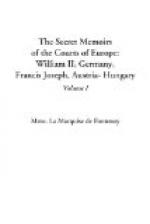When Francis-Joseph is in Hungary he invariably wears either the undress or full-dress uniform of a Hungarian general, and it must be confessed that, in spite of the somewhat theatrical appearance of the gold embroidered, tight-fitting scarlet pantaloons and gold-topped high boots, the scarlet gold-laced tunic of the full dress, with the heron-plumed kalpak, or the slightly less gorgeous “shako,” and blue-grey, gold-laced tunic of the undress uniform, he looks remarkably well, thanks to the extraordinary elasticity and elegance which he has retained in spite of his three-score years and ten.
Emperor William’s ordinary garb is the familiar undress uniform of a Prussian general, the dark-blue long frock coat, with its double row of silver buttons, its scarlet collar, and its silver shoulder-straps. The trousers are of the same hue as the coat, with broad scarlet stripes, the latter being worn only by generals. Hanging from the collar is usually the cross of the Brandenburg Langue of the Order of St. John of Jerusalem, while on the breast is fastened a sort of star, consisting of the letter “W” encircled by gold laurel leaves, which has been accorded to all the officers who formed part of the household of Old Emperor William. The cap is the ordinary flat, black vizored undress headgear of all the officers of the German army.
The uniforms which the emperor wears on state occasions are either the full-dress uniform of a Prussian general, richly-embroidered, dark-blue tunic, and epaulets, with a helmet surmounted by the white plumes of a field officer, or else the regimentals of a colonel-in-chief of the gardes-du-corps. In the latter, the emperor looks exceedingly well, especially on horseback. The helmet is surmounted by a silver eagle with outstretched wings, the white tunic is partly concealed by a silver cuirass, adorned with a gold sun, and with the white, tight-fitting knee-breeches are worn high jack-boots. In fact, it is no flattery to Emperor William to declare that his appearance in this uniform invariably suggests “Lohengrin.” At court entertainments, in the evening, he frequently wears the so-called gala, or court dress of this regiment. The coat is scarlet instead of white, while the cuirass is abandoned. Sometimes the emperor attires himself in the uniform of a colonel of the Hussar regiment which he commanded at the time of his accession to the throne. It is scarlet, gold-laced, and the tight-fitting scarlet pantaloons are worn with knee-boots, topped with gold.
The emperor is likewise very fond of donning naval attire, being particularly proud of his connection with the fleet of Germany and those of a number of foreign countries. Indeed, it may be safely asserted that if there is any one foreign dignity which he cherishes extremely, it is that of admiral of the fleet in the British navy, conferred upon him by his grandmother, Queen Victoria.




